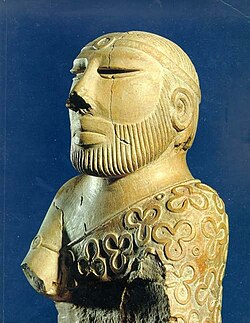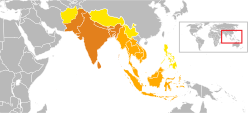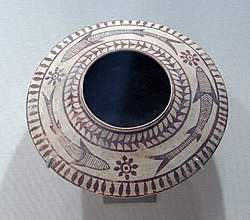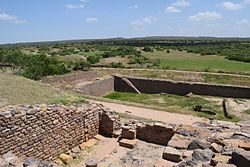History of India
The history of India covers thousands of years and discusses many diverse languages, cultures, periods, and dynasties in India. Civilisation there began in the Indus Valley, and some literature survives from that time.
Stone age
Paleolithic era
Remains (stone tools and a skull) in central India show presence of an early species of humans, Homo erectus.[1] Archeologists think they lived in India between 200,000 and 500,000 years ago. This period is known as the Paleolithic era.
The earliest archaeological site in the subcontinent is the paleolithic hominid site in the Soan River Valley.[2] Soanian sites are found in the Sivalik region across India, Pakistan and Nepal.[3]
Mesolithic
Modern humans (Homo sapiens) settled in the Indian subcontinent at least 70,000 years ago. The last ice age had then just ended, and the climate became warm and dry. The first settlements are found in Bhimbetka, near Bhopal (Madhya Pradesh, India). Mesolithic people lived by hunting, fishing and food gathering.
Neolithic
Neolithic agriculture started in the Indus Valley region around 7000 years ago in the lower Gangetic Valley around 5000 years ago. Later, in South India, agriculture spread southwards and also into Malwa around 3800 years ago.
Bronze Age

The Bronze Age in the Indian subcontinent began around 5300 years ago with the early Indus Valley Civilisation, which included cities such as Harappa, Mohenjodaro, Lothal, and Kalibanga. The civilization was based on the Indus River and its tributaries and extended into the Ghaggar-Hakra River valley,[4] the Ganges-Yamuna Doab,[5] Gujarat,[6] and southeastern Afghanistan.[7] Today, the civilization's old territory is split between India and Pakistan. In Pakistan, the provinces of Sindh, Punjab, and Balochistan overlap with ex-Indus Valley territory. In India, the provinces Gujarat, Haryana, Punjab and Rajasthan also share territory with the Indus Valley civilisation.
The first cities on the Indian subcontinent were part of the Indus Valley civilisation.[8] They were similar to those of early Mesopotamian civilisations and Ancient Egypt.[9] Inhabitants of the ancient Indus river valley, the Harappans, developed new techniques in metallurgy and handicraft (carneol products, seal carving), and produced copper, bronze, lead, and tin.
The mature Indus civilization flourished from about 4600 to 3900 years ago. It included urban centres such as Dholavira, Kalibanga, Ropar, Rakhigarhi, and Lothal, in modern-day India, and Harappa, Ganeriwala, and Mohenjo-daro in modern-day Pakistan. The cities were built of brick, with roadside drainage system and multi-storied houses. During the later period of this civilisation, signs of a gradual decline began to emerge. By about 3700 years ago, most of the cities were abandoned. However, the Indus Valley civilisation did not disappear suddenly. Some parts of the civilisation may have survived in the smaller villages and isolated farms.
Vedic civilization
The Vedas are the oldest teachings of India though the transmission of them was mainly oral until around the 5th century. There are four Vedas, and the oldest is the Rigveda. According to the Rigveda, the whole region is Sapta Sindhawa, the land of seven rivers.[10] The other three are Samaveda, Yajurveda and Atharvaveda. The Vedas have verses in praise of gods and others. They also have other information. The society was then pastoral.
After the Rigveda, society became more agricultural. People became divided into four classes depending on the type of the work. Brahmins were priests and teachers. Kshatriyas were the warriors. Vaishyas did agriculture, trading and commerce. The shudras were the general working class. The Vaishyas and Shudras were not always looked down upon and treated badly by Brahmins and Kshatriyas. They were during the later part of the Vedic age but not during the earlier part. This type of social division is called the Varna system in Hinduism.
During the period of the Later Vedic civilization, there were many Aryan clans and tribes. Some of them combined and became larger like the kingdom of the Kurus.
Persian and Greek invasion
The names "India" and "Hind" came from the Greek and Persian and mean "land of the Indus River" in both languages.[11]
Around the 5th century BC, northwestern parts of India were invaded by the Persians, who ruled the Achaemenid Empire, and by the Greeks, led by Alexander the Great. A Persian way of thinking, administration, and lifestyle came to India. Its influence became more important during the Mauryan dynasty.
From around 520 BC, Achaemenid Emperor Darius I ruled large part of northwestern parts of the Indian subcontinent for about 186 years until Alexander conquered those areas. In modern times, there are still traces of this Greek heritage to be found in parts of northwestern India. Greco-Buddhism is a combination of the cultures of Greece and Buddhism. This mixture of cultures developed for 800 years, from the 4th century BC until the 5th century AD. The area where it happened what are now Afghanistan and Pakistan. This mixture of cultures influenced Mahayana Buddhism and the spread of Buddhism to China, Korea, Japan and Tibet.
Magadha
Magadha was one of the sixteen kingdoms in ancient India. The core of the kingdom was the area of Bihar south of the Ganges. It capital was first Rajagriha (modern Rajgir) but later was moved to Pataliputra (modern Patna). Magadha expanded to include most of Bihar and Bengal,[12] followed by much of eastern Uttar Pradesh and Odisha. The ancient Kingdom of Magadha is mentioned in Jain and Buddhist texts. It was also mentioned in the Indian epics Ramayana and Mahabharata.[13][unreliable source?] The state was a historic Iron Age kingdom and had been recorded in Vedic texts much earlier than 600 BC.
Magadha played an important role in the development of Jainism and Buddhism, and two of India's greatest empires, the Maurya Empire and Gupta Empire, originated from Magadha. The Mauryan Empire when it was led by Ashoka was a highly centralized-state and managed to unite most of the Indian subcontinent for the first time. Ashoka also helped to spread Buddhism. The Gupta Empire saw advances in science, mathematics, astronomy, religion and philosophy and is traditionally considered India's golden age. Historians place the Gupta dynasty alongside the Han Dynasty, the Tang Dynasty and the Roman Empire as a model of a classical civilisation.
Early middle kingdoms
Satavahana Empire
The Satavahanas, also called the Andhras, came to power from around 230 BC. They are also called Andhras. For about 450 years, Satavahanas kings ruled most parts of the southern and central India.
Western Kshatrapas
For about 350 years, from the years 35-405, Saka kings ruled the weste and the centre of India. These areas are in today's states of Gujarat, Maharashtra, Rajasthan, and Madhya Pradesh. There were 27 independent rulers, who were collectively known as the Kshatrapas.
The Saka kings ruled India along aside the Kushan kings and the Satvahana kings. Kushan kings ruled the north of India. Satvahana kings ruled the centre and some of the south of India.
Indo-Scythians
Indo-Scythians came to India from Siberia after they had passed through Bactria, Sogdiana, Kashmir and Arachosia. They continued to come coming to India continued from the 2nd century BC to the 1st century BC. They defeated the Indo-Greek rulers of India and ruled India from Gandhara to Mathura.
Gupta dynasty
The Gupta dynasty reigned from around 320 to 550 AD. The Gupta Empire covered most of north-central India and what is now western India and Bangladesh. Gupta society was ordered in accordance with Hindu beliefs. The empire saw advances in science, mathematics, astronomy, religion, and philosophy and is traditionally considered India's Golden age. Historians place the Gupta dynasty alongside the Han Dynasty, the Tang Dynasty and the Roman Empire as a model of a classical civilisation.
Hun invasion

By the first half of the fifth century, a group of people known as the Huns had settled in Afghanistan. They became powerful and made made Bamiyan their capital city. They started attacking north-westernern India. Skandagupta, an emperor of the Gupta dynasty, fought back and kept them away for some years. At last, the Huns won and entered most of northern India, and the Gupta dynasty came to an end. Most of North India became badly affected by this invasion. However, Huns could not go up to the Deccan Plateau and the south of India and so those areas remained peaceful. No one knows definitely about the fate of Huns after the end of the sixth century. Some historians believe that they fully assimilated with the local Indian people.
Late Middle Kingdoms
The Middle Kingdoms cover a period of Indian history beginning from around the 6th and the 7th century. In South India, the Chola kings ruled Tamil Nadu, and the Chera kings ruled Kerala. They also had trading relationships with the Roman Empire to the west and with Southeast Asia to the east. In North India, the Rajputs ruled in many kingdoms. Some of those kingdoms continued for hundreds of years.
Harsha's empire
After the collapse of the Gupta Empire, Harsha of Kanauj, a place now in Uttar Pradesh, united northern India into one kingdom. After his deathm several dynasties tried to control the area and ruled from the 7th century to the 9th centuriesm as described below. Some of those dynasties were the Pratiharas of Malwa and later Kannauj; the Palas of Bengal, and the Rashtrakutas of the Deccan Plateau.
The Pratiharas, Palas, and Rashtrakutas
The Pratihara kings ruled kingdoms in Rajasthan and some other parts of northern India from the 6th century to the 11th century. The Palas ruled the eastern part of India in areas that are now parts of the Indian states of Bihar, Jharkhand, West Bengal and of Bangladesh. The Palas ruled from 8th to the 12th centuries. In southern India, Rashtrakutas of Malakheda (Karnataka) ruled the Deccan Plateau from the 8th to the 10th centuries after the end of Chalukya rule. All three dynasties tried to control all of northern India. For three to four hundred years, the Chola kings were growing in power and influence.
Rajput kingdomss
In the 6th century, several Rajput kingdoms came into being in Rajasthan. Many other Rajput kings ruled in different parts of North India. Some of theoe kingdoms survived for hundreds of years.
Vijayanagar Empire
In 1336, two brothers named Harihara and Bukka founded the Vijayanagara Empire in an area that is now in Karnataka. The most famous king of the dynasty was Krishnadevaraya. In 1565, its rulers were defeated in a battle, but the empire continued for about a hundred more years.
A number of kingdoms of South India had trading relations with the Arabs in the west and with Indonesia and other countries of the east.
Islamic sultanates
Islam spread across the Indian subcontinent over a period of 500 years. In the 10th and the 11th centuries, Turks invaded India and established sultanates in Delhi. In the early 16th century, descendants of Genghis Khan swept across the Khyber Pass and established the Mughal Empire, which lasted for 200 years. From the 11th to the 15th centuries, southern India was dominated by the Chola and Vijayanagar Empires. The two systems, the prevailing Hindu and the competing Muslim, mingled and left lasting cultural influences on each other.
Delhi sultanate
The Delhi sultanate was a Muslim kingdom based mostly in Delhi. It ruled large parts of the Indian subcontinent for 320 years (1206–1526) with five dynasties over its lifespan: the Mamaluk, Khallji, Tughlaq, sayyid and Lodi dynasties. The Mamluk dynasty was started by Qutb ud-Din Aibak. Since he was a slave, the dynasty ws also called Slave dynasty. He also started construction of the Qutub Minar. His son-in-law Iltutmish became the ruler after him and completed the Qutub Minar.
Kingdom of Mysore
The Kingdom of Mysore was a kingdom of southern India. People known as Wodeyars founded it in1400. Later, Hyder Ali and his son, Tipu Sultan, fought with the Wodeyar rulers. They also fought with the forces of the British Raj but were defeated. Under the British Raj, the Wodeyar kings continued to rule a large part of Karnataka. When India became independent on 15 August 1947, the kingdom chose to become part of India.
Punjab
Guru Nanak founded Sikhism, and his followers were called Sikhs. Their power oincreased in northwestern India. The Sikhs became rulers of much of the northwestern India in what was called the Sikh Kingdom or Empire. Ranjit Singh was its most famous ruler amd expanded its borders. At the time of his death, it covered areas of Punjab and present-day Kashmir and parts of Pakistan. The Sikhs the British Raj fought many wars. While Maharaja Ranjit Singh was alive, the British could not to cross the Sutlej River. After his death, they took over the entire Punjab after battles with disorganised Sikh troops. Many Sikhs later fought for the British.
Durrani Empire
For a short period, Ahmad Shah Durrani, the founder of Afghanistan, ruled parts of northwestern India. Historians have named his rule the Durrani Empire. In 1748, he crossed the Indus River and attacked Lahore, now in Pakistan. He also attacked many parts of Punjab. Then, he attacked Delhi, which was the capital of the Mughal Empire. He looted many valuable things from India such as the Peacock Throne of Shah Jahan and the famous diamond Kohinoor.
Colonial era
Colonial period means the time when Western countries ruled India. The West also ruled many places in the rest of Asia, as well as in Africa and the Americas.
Company Rule
In the 1600s, the East India Company began a very profitable trading empire in India, centred on Bengal. In the mid-1700sm Robert Clive (1725-1774) led the company to an expanded influence in India with victories over the French, the Bengalis, and the Mughals. With a victory at the Battle of Plassey in 1757, Clive became the first British Governor of Bengal.
In the 100 years after the battle, the East India Company conquered the entire Indian subcontinent by trade, political intrigue, and direct military action. In1857, the Indian Rebellion almost ended company rule in India. The British government then took control away from the company. In 1858, India became part of the British Empire, and Queen Victoria became the Empress of India.
British Raj
For the next 100 years, the British ruled most of India, which included Burma, as an informal empire. India was divided into eight provinces, each with a governor: Burma, Bengal, Madras, Bombay, Uttar Pradesh, the Central Provinces, Punjab, and Assam. The Governor-General, also called the Viceroy, in Calcutta (later Dehli)was head of the government.
It should be noted that the British did not control all of what is nowIndia, and not all of it all under direct British rule. A large part of the British Raj was made up of vassal princely states, whicj were governed by local rulers.
Goa was under Portuguese rule, and the four cities that are modern-day Pondicherry were under French sovereignty.
British colonial exploitation resulted in the deaths of millions of Indians from starvation and famine.[14] The British, however, also introduced railways and banned the sati, the suicide of a widow in her husband's funeral pyre..[15]
Independence
Many people in India wanted to be free from British rule. The struggle for freedom was long and difficult. Many people protested against the injustices of British rule. The most important leader of the independence movement was Mahatma Gandhi, who believed in peaceful opposition towards the British. Muhammad Ali Jinnah wanted a separate state for Muslims living in the Indian subcontinent and so British India was divided into two countries: Pakistan and India. The partition resulted in violence that led to the deaths of many people: both Hindus and Muslims. India won its independence on August 15, 1947. Pakistan had won its independence a day earlier.
Republic of India
On 26 January 1950, India adopted a constitution. From that day, India become a republic.
During last 60 years, the Republic of India has seen different stages in its national life:
- It fought three wars against Pakistan and one war against China. Wars against Pakistan were fought in 1947, 1965, and 1971. The relationship between India and Pakistan haas been very tense abd probably be for a long time. In 1999, it had a limited skirmish in Kargil. A war against China was fought in 1962. In 1971, India also helped Bangladesh fight for indpendence from Pakistan.
- Under the leadership of Jawaharlal Nehru, the country's first Prime Minister, India had adopted a socialist economy. Some economists think it was a mixed economy since socialism and capitalism continued together. During this period, lasting for several years up to end-1980s, India rapidly developed its infrastructure, science and technology.
- By the early 1990s, India had changed its economic policies. It started several reforms to attract more capital from other countries. Local businessmen and industrialists also got more freedom to carry out their activities.
- In 1974, India had already launched its first nuclear bomb. It launched another in 1998. It thus became a nuclear power.
In 2018, India was the fifth-largest economy in terms of gross domestic product and the fourth-largest economy in terms of purchasing power parity. Some economists think that in the coming decades, India’s economy will become still larger.
History Of India Media
Indian cultural influence (Greater India)
Mehrgarh site in present-day Balochistan, Pakistan
Mohenjo-daro (one of the largest Indus cities). View of the site's Great Bath, showing the surrounding urban layout.
Archaeological remains of washroom drainage system at Lothal
Three stamp seals and their impressions showing Indus script characters alongside animals: unicorn (left), bull (centre), and elephant (right); at Guimet Museum
Related pages
References
- ↑ "The Hathnora Skull Fossil from Madhya Pradesh, India". Multi Disciplinary Geoscientific Studies. Geological Survey of India. 2005. Archived from the original on 19 June 2007. Retrieved 7 May 2007.
- ↑ Rendell H.R.; Dennell R.W. and Halim M (1989). Pleistocene and Palaeolithic investigations in the Soan Valley, northern Pakistan. British Archaeological Reports International Series. Cambridge University Press. p. 364. ISBN 0-86054-691-8. OCLC 29222688.
- ↑ Parth R. Chauhan. Distribution of Acheulian sites in the Siwalik region. An overview of the Siwalik acheulian & reconsidering its chronological relationship with the Soanian – a theoretical perspective.
- ↑ Possehl G.L. (1990). "Revolution in the urban revolution: the mergence of Indus urbanisation". Annual Review of Anthropology. 19 (1): 261–282. doi:10.1146/annurev.an.19.100190.001401. ISSN 0084-6570. Retrieved 6 May 2007.See map on page 263
- ↑ Indian archaeology, a review. 1958-1959. Excavations at Alamgirpur. Delhi: Archaeol. Surv. India, pp. 51–52.
- ↑ Leshnik L.S. (1968). "The Harappan "port" at Lothal: another view". American Anthropologist, New Series. 70 (5): 911–922. doi:10.1525/aa.1968.70.5.02a00070. JSTOR 196810.
- ↑ Kenoyer, Jonathan (1998). Ancient cities of the Indus Valley Civilisation. USA: Oxford University Press. p. 96. ISBN 0-19-577940-1.
- ↑ Kenoyer, J. Mark (1998). The Ancient cities of the Indus Valley Civilisation. Oxford University Press. ISBN 0-19-577940-1. OCLC 231832104.
- ↑ "History". Incredible India. Archived from the original on 2009-05-02. Retrieved 2019-03-18.
- ↑ "Sapta Sindhavas The Land of Seven Rivers" (PDF). Dr Aslamkhan.
- ↑ "Etymology of the Name India". Sanujit. World History Encyclopedia.
- ↑ Ramesh Chandra Majumdar (1977). Ancient India. Motilal Banarsidass Publishers. ISBN 81-208-0436-8.
- ↑ "Magadha Empire". Archived from the original on 2018-01-04. Retrieved 2016-03-20.
- ↑ Harari, Yuval (2014). Sapiens: A Brief History of Humankind. Harper. ISBN 978-0062316097.
- ↑ Harari, Yuval (2014). Sapiens: A Brief History of Humankind. Harper. ISBN 978-0062316097.
More reading
- Benedetti, Giacomo. "The idea of India in ancient Indian texts: āryāvarta, jambudvīpa, bhāratavarṣa and the relation with non-āryas."
- Allan, J. T. Wolseley Haig, and H. H. Dodwell, The Cambridge Shorter History of India (1934)
- Majumdar, R. C., H.C. Raychaudhuri, and Kaukinkar Datta. An Advanced History of India London: Macmillan. 1960. ISBN 0-333-90298-X
- Smith, Vincent. The Oxford History of India in(1981)
Other websites
- A Concise History of India
- Indian History Timeline Archived 2021-07-16 at the Wayback Machine











